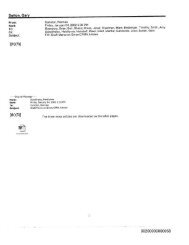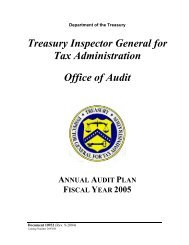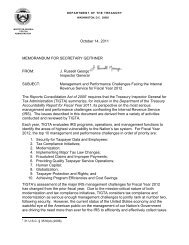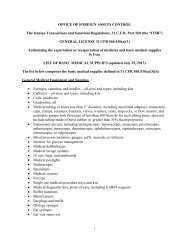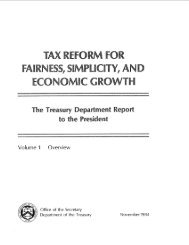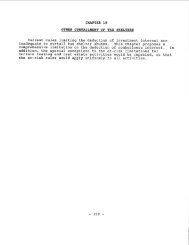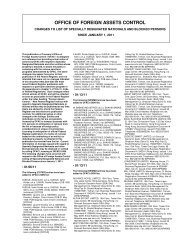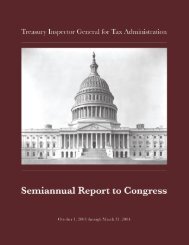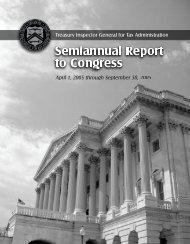Treasury Analysis of Build America Bonds Issuance and Savings ...
Treasury Analysis of Build America Bonds Issuance and Savings ...
Treasury Analysis of Build America Bonds Issuance and Savings ...
You also want an ePaper? Increase the reach of your titles
YUMPU automatically turns print PDFs into web optimized ePapers that Google loves.
U.S. TREASURY DEPARTMENT<br />
<strong>Treasury</strong> <strong>Analysis</strong> <strong>of</strong><br />
<strong>Build</strong> <strong>America</strong> <strong>Bonds</strong> <strong>Issuance</strong> <strong>and</strong> <strong>Savings</strong><br />
Over $180 billion <strong>of</strong> <strong>Build</strong> <strong>America</strong> <strong>Bonds</strong> were issued over the lifetime <strong>of</strong> the program<br />
State <strong>and</strong> local governments reaped approximately $20 billion in present value<br />
savings from issuing <strong>Build</strong> <strong>America</strong> <strong>Bonds</strong><br />
The President’s FY2012 Budget proposes to reinstate <strong>and</strong> exp<strong>and</strong> the<br />
<strong>Build</strong> <strong>America</strong> <strong>Bonds</strong> program<br />
May 16, 2011<br />
1
Executive Summary<br />
This <strong>Treasury</strong> report examines the effects <strong>of</strong> <strong>Build</strong> <strong>America</strong> <strong>Bonds</strong> (BABs) on issuer borrowing<br />
costs. Introduced as part <strong>of</strong> the <strong>America</strong>n Recovery <strong>and</strong> Reinvestment Act <strong>of</strong> 2009, BABs are<br />
taxable bonds for which the U.S. <strong>Treasury</strong> Department pays a 35 percent direct subsidy to the<br />
issuer to <strong>of</strong>fset borrowing costs. BABs had a very strong reception from both issuers <strong>and</strong><br />
investors. From the inception <strong>of</strong> the program in April 2009 to when it expired on December 31,<br />
2010, there were 2,275 separate BABs issues, which supported more than $181 billion <strong>of</strong><br />
financing for new public capital infrastructure projects such as schools, bridges <strong>and</strong> hospitals.<br />
The empirical analysis presented in this report indicates that state <strong>and</strong> local governments that<br />
issued BABs realized considerable savings as compared to the cost <strong>of</strong> issuing tax-exempt bonds.<br />
This report provides evidence that President Obama’s proposal to extend <strong>and</strong> exp<strong>and</strong> the BABs<br />
program would lead to continued savings on borrowing costs for state <strong>and</strong> local governments.<br />
Summary <strong>of</strong> Results:<br />
There was a very strong market reception for BABs. Over the lifetime <strong>of</strong> the<br />
program, $181 billion in BABs were issued by state <strong>and</strong> local governments in all<br />
50 states, the District <strong>of</strong> Columbia <strong>and</strong> two territories.<br />
BABs issuers received significant savings. Exp<strong>and</strong>ing on an April 2010 analysis, this<br />
report estimates that BABs issuers saved, on average, 84 basis points on interest costs for<br />
30-year bonds <strong>and</strong> also received significant savings on shorter maturities, as compared to<br />
traditional tax-exempt bonds.<br />
BABs issuers saved an estimated $20 billion in borrowing costs. Due to the large<br />
savings in interest costs, state <strong>and</strong> local governments that issued BABs saved an<br />
estimated $20 billion in borrowing costs, on a present value basis, as compared to<br />
tax-exempt bonds. This is considerably greater than the net cost to the federal<br />
government <strong>of</strong> the BABs program.<br />
The President’s FY2012 proposal to reinstate <strong>and</strong> exp<strong>and</strong> BABs at a revenue<br />
neutral rate would benefit municipalities, retail investors <strong>and</strong> the municipal bond<br />
market.<br />
2
Background<br />
The financial crisis <strong>of</strong> 2008 severely impaired credit markets for state <strong>and</strong> local governments.<br />
Like other financial markets, the municipal bond market faced liquidity, credit, <strong>and</strong> market<br />
access constraints with widespread aversion to risk exposure during this time. In addition,<br />
features particular to the municipal bond market – including credit rating downgrades <strong>of</strong> large<br />
monoline bond insurers <strong>and</strong> auction failures in February 2008 affecting nearly $300 billion in<br />
auction rate securities – exacerbated the turmoil. By the fourth quarter <strong>of</strong> 2008, monthly<br />
issuance had fallen to 68 percent <strong>of</strong> pre-crisis levels, the relative cost <strong>of</strong> borrowing had increased<br />
by more than 100 percent, <strong>and</strong> many municipal issuers had no access to the capital markets.<br />
Without access to financing, many state <strong>and</strong> local governments were forced to put infrastructure<br />
<strong>and</strong> capital projects on hold, which contributed to a larger contraction in aggregate dem<strong>and</strong>. The<br />
projects that were successfully financed required higher costs than usual, putting additional strain<br />
on already stressed budgets.<br />
In February 2009, the Administration <strong>and</strong> Congress passed the <strong>America</strong>n Reinvestment <strong>and</strong><br />
Recovery Act <strong>of</strong> 2009 (the Recovery Act) to address the economic contraction caused by the<br />
financial crisis. The Recovery Act included many provisions that provided direct support to state<br />
<strong>and</strong> local governments, including $151 billion in grants to help address revenue shortfalls <strong>and</strong><br />
support ongoing expenditures.<br />
The Recovery Act also included <strong>Build</strong> <strong>America</strong> <strong>Bonds</strong> (BABs) program. This program, which<br />
enjoyed bipartisan support, provided an innovative new lower cost borrowing tool for state <strong>and</strong><br />
local governments. BABs are taxable bonds for which <strong>Treasury</strong> pays a 35 percent direct subsidy<br />
to the issuer to <strong>of</strong>fset borrowing costs.<br />
BABs Broaden the Market for Municipal Borrowing<br />
At a time when borrowers <strong>of</strong> all kinds were struggling to obtain financing, BABs provided a<br />
much needed expansion <strong>of</strong> opportunities for state <strong>and</strong> local governments to access credit. Since<br />
BABs are taxable bonds which were sold without regard to tax status, they appeal equally to<br />
investors that do not have tax liability, including pension funds <strong>and</strong> other long term institutional<br />
investors, <strong>and</strong> to traditional investors <strong>of</strong> tax-exempt bonds. Moreover, BABs are equally<br />
attractive to middle class taxpayers, which helps to diversify the base <strong>of</strong> retail investors.<br />
The increase in potential investors is substantial: whereas the traditional tax-exempt bond market<br />
has a total size <strong>of</strong> about $2.8 trillion <strong>and</strong> a predominately retail investor base (individuals <strong>and</strong><br />
mutual funds own 70 percent <strong>of</strong> tax-exempt bonds), the BABs program provides access to the<br />
3
much bigger $30 trillion conventional taxable bond market, which includes more long-term<br />
institutional investors.<br />
Figure 1: BABs <strong>Issuance</strong> <strong>and</strong> Tax-Exempt Yields<br />
Source: Data are from Bloomberg<br />
By broadening the set <strong>of</strong> investors interested in holding municipal bonds, BABs helped to reduce<br />
issuer borrowing costs, especially on longer maturity issues. 1 The benefits were significant not<br />
only for BABs issuers, but traditional tax-exempt issuers as well. As the investor base broadens,<br />
tax-exempt issuers benefit from reduced supply pressure. As is evident in the chart above,<br />
around the time that BABs were introduced, yields on tax-exempt bonds fell from historic highs<br />
to slightly above pre-crisis levels.<br />
BABs Improve Efficiency<br />
In addition to broadening the market for municipal bonds, BABs more efficiently deliver the<br />
federal subsidy for state <strong>and</strong> local government borrowing because each dollar <strong>of</strong> subsidy goes<br />
directly to the issuer. By comparison, the subsidy for tax-exempt bonds is widely considered to<br />
be inefficient because federal revenue costs (in lost federal taxes) are greater than benefits to<br />
state <strong>and</strong> local governments (in lower borrowing costs). 2<br />
1 For example, The Bond Buyer reported that analysts from Citigroup find that “yield savings to issuers on longer<br />
term BAB issues continue to be in the 80 to 100 basis point range, before the value <strong>of</strong> the call option is considered.”<br />
(See Bond Buyer “Market Close: Muni Finish Unchanged to Slightly Firmer”, May 18, 2009)<br />
2 See “Subsidizing Infrastructure Investment with Tax-Preferred <strong>Bonds</strong>,” CBO/JCT, October 2009<br />
http://www.cbo.gov/ftpdocs/106xx/doc10667/10-26-TaxPreferred<strong>Bonds</strong>.pdf<br />
4
Since 1986, interest rates on long-term investment grade tax-exempt bonds have averaged about<br />
20 percent lower than comparable corporate taxable bonds whereas Federal revenue costs for<br />
tax-exempt bonds have averaged about 25-30 percent.<br />
BABs also have a more streamlined tax compliance framework that focuses directly on<br />
governmental issuers who benefit from the subsidy, as compared with tax-exempt bonds <strong>and</strong> tax<br />
credit bonds, which involve investors as tax intermediaries.<br />
Further, in a July 2010 report, the <strong>Treasury</strong> Inspector General for Tax Administration determined<br />
that, in its initial administration <strong>of</strong> the BABs program, the IRS generally processed all complete<br />
requests for the BABs Federal subsidy payments accurately, timely, <strong>and</strong> without indications <strong>of</strong><br />
fraudulent or erroneous disbursement. 3<br />
BABs <strong>Issuance</strong><br />
BABs <strong>Issuance</strong> Over Time<br />
From the inception <strong>of</strong> the program in April 2009 to December 31, 2011, there were 2,275<br />
separate BABs issues for over $181 billion <strong>of</strong> total BAB issuance. 4<br />
Source: Data are from Bloomberg<br />
Figure 2: Monthly BABs <strong>Issuance</strong><br />
3 See TIGTA Report, entitled “Initial <strong>Build</strong> <strong>America</strong> Bond Subsidy Payments Were Processed Accurately <strong>and</strong><br />
Timely” (July 14, 2010) at: http://www.treas.gov/tigta/auditreports/2010reports/201011083fr.pdf.<br />
4 Data on aggregate BABs issuance by state <strong>and</strong> by month can be found on the <strong>Treasury</strong> website at:<br />
http://www.treasury.gov/initiatives/recovery/Pages/babs.aspx In addition, the website provides state-level tables<br />
with details on each <strong>of</strong> the 2,275 BABs issuances.<br />
5
The first few months <strong>of</strong> the BABs program issuance averaged $5.8 billion per month <strong>and</strong><br />
constituting only 16 percent <strong>of</strong> the total municipal bond issuance through September 2009. By<br />
end <strong>of</strong> 2009, issuers <strong>and</strong> investors had developed familiarity with the program <strong>and</strong> issuance<br />
increased accordingly. From October 2009 to June 2010, BABs issuance averaged nearly $9<br />
billion per month <strong>and</strong> constituted 24 percent <strong>of</strong> all issuance.<br />
BABs issuance slowed slightly in the summer <strong>of</strong> 2010 <strong>and</strong> fell to $5.4 billion or 16 percent <strong>of</strong> all<br />
municipal bonds issued in August 2010. BABs issuance then surged in the final quarter <strong>of</strong> 2010.<br />
Many state <strong>and</strong> local governments appear to have accelerated the timing <strong>of</strong> financings <strong>of</strong> needed<br />
public capital projects in 2010 in anticipation <strong>of</strong> the scheduled expiration <strong>of</strong> the program on<br />
December 31, 2010, which was consistent with the objective <strong>of</strong> the Recovery Act to stimulate<br />
capital investment. In the last three months <strong>of</strong> 2010, BABs issuance averaged $14.4 billion <strong>and</strong><br />
constituted one-third <strong>of</strong> the market. In December 2010, BABs constituted nearly 50 percent <strong>of</strong><br />
all municipal issuance.<br />
BABs <strong>Issuance</strong> by State<br />
BABs were issued in all 50 states, the District <strong>of</strong> Columbia, <strong>and</strong> two territories. The table below<br />
presents state-by-state issuance totals.<br />
BABs have been used by small issuers, such as Cass County School District in Nebraska, to<br />
finance construction <strong>of</strong> local schools, firehouses, <strong>and</strong> community centers. At the same time,<br />
BABs have been used by large issuers, such as the Bay Area Toll Authority, to finance major<br />
infrastructure initiatives <strong>and</strong> capital projects. BABs were only available for capital financing <strong>and</strong><br />
could not be used for cash management or for closing budget shortfalls.<br />
6
Total<br />
<strong>Issuance</strong><br />
($Millions)<br />
Table 1: BABs <strong>Issuance</strong> by State<br />
Total<br />
<strong>Issuance</strong><br />
($Millions)<br />
State /<br />
No. <strong>of</strong> State /<br />
No. <strong>of</strong><br />
Territory<br />
Issues Territory<br />
Issues<br />
AK 358 5 NC 1,623 36<br />
AL 614 18 ND 68 7<br />
AR 40 3 NE 1,008 60<br />
AZ 1,978 39 NH 355 6<br />
CA 37,680 158 NJ 7,364 33<br />
CO 4,074 63 NM 276 7<br />
CT 1,915 19 NV 2,562 25<br />
DC 1,950 8 NY 20,630 59<br />
DE 519 6 OH 8,344 123<br />
FL 5,537 75 OK 816 29<br />
GA 3,729 17 OR 971 8<br />
HI 1,268 7 PA 5,022 64<br />
IA 760 37 PR 1,013 5<br />
ID 143 6 RI 12 1<br />
IL 11,231 245 SC 1,193 32<br />
IN 2,072 38 SD 355 22<br />
KS 1,629 55 TN 1,836 42<br />
KY 2,975 105 TX 16,676 95<br />
LA 949 9 UT 2,900 47<br />
MA 4,836 17 VA 3,821 45<br />
MD 3,465 40 VI 37 1<br />
ME 88 3 VT 126 4<br />
MI 2,625 70 WA 6,133 89<br />
MN 1,495 115 WI 2,170 142<br />
MO 2,992 120 WV 88 2<br />
MS 765 6 WY 142 6<br />
MT 30 1 Total 181,256 2,275<br />
Source: Data are from Bloomberg<br />
BABs <strong>Savings</strong><br />
An April 2010 <strong>Treasury</strong> report outlined a new method for estimating the savings to BABs<br />
issuers, as compared to the cost <strong>of</strong> issuing tax-exempt bonds. This estimation method relied on<br />
comparing BABs yields with tax-exempt yields for a selected sample <strong>of</strong> issuers who issued both<br />
BABs <strong>and</strong> tax-exempt bonds on the same day.<br />
This estimation method allows for a comparison that nets out any differences between BABs <strong>and</strong><br />
tax-exempt bonds that are due to issuer-specific characteristics or to trends in bond yields over<br />
time. This approach eliminates many potential sources <strong>of</strong> the difference between BABs <strong>and</strong> taxexempt<br />
yields that are unrelated to the direct effect <strong>of</strong> the BABs program. For example, BABs<br />
issuers may have consistently different risk pr<strong>of</strong>iles than non-BABs issuers. Also, interest rates<br />
7
vary from day to day, <strong>and</strong> changed considerably throughout the two years that BABs were<br />
available. Failure to account for such differences, including differences in risk pr<strong>of</strong>iles or in time<br />
<strong>of</strong> issuance, could affect the accuracy <strong>of</strong> the comparison <strong>of</strong> BABs <strong>and</strong> tax-exempt yields <strong>and</strong><br />
confound the estimates <strong>of</strong> the direct effect <strong>of</strong> the program. The estimation method in this<br />
analysis also controls for several observed characteristics <strong>of</strong> the bonds themselves, including<br />
their maturity <strong>and</strong> call features.<br />
Additional details on the “fixed-effects” regression models used in this estimation can be found<br />
in the April 2010 <strong>Treasury</strong> Report, available online at:<br />
http://www.treasury.gov/initiatives/recovery/Documents/BABs-Report-4-2-2010-FINAL.pdf<br />
The Sample <strong>of</strong> Paired Issues<br />
The previous analysis consisted <strong>of</strong> 92 cases in which both BABs <strong>and</strong> tax-exempt bonds were<br />
issued by the same issuer on the same day from April to September <strong>of</strong> 2009. By adding over a<br />
year <strong>of</strong> additional data, the current analysis is able to exp<strong>and</strong> the estimation sample to 528 cases<br />
<strong>of</strong> paired issuers.<br />
As before, many <strong>of</strong> these cases are serial bonds, so the sample consists <strong>of</strong> 11,156 separate BABs<br />
<strong>and</strong> tax-exempt bond placements. In this sample, as in the universe <strong>of</strong> BABs more generally, the<br />
BABs tend to be issued at longer maturities than tax-exempt bonds. The average maturity for<br />
BABs in the analysis sample is 14.3 years, whereas the average maturity for tax-exempt bonds is<br />
only 8.2 years. Given the difference in maturities, it is very important to flexibly control for<br />
maturity in the analysis.<br />
Estimation Results: BABs Offer <strong>Savings</strong> at Longer Maturities<br />
Figure 3 summarizes the regression estimates. The figure provides the average yield at various<br />
maturities for BABs <strong>and</strong> tax-exempt bonds that were issued by state <strong>and</strong> local governments that<br />
issued both types <strong>of</strong> bonds on the same day, controlling for other factors. In addition, the dashed<br />
line shows the yield cost <strong>of</strong> BABs after deducting the 35 percent subsidy to the issuer.<br />
On average, BABs have provided savings at longer maturities, <strong>and</strong> provided greater savings at<br />
very long maturities. The savings on the yield for a 30-year bond is 84 basis points in this<br />
sample. Statistical tests indicate that these differences are very unlikely to have occurred by<br />
chance.<br />
8
Predicted yield (bps)<br />
200 400 600<br />
0<br />
Predicted Yields: BABs v Tax-Exempt <strong>Bonds</strong><br />
Figure 3: Predicted Full Sample: Yields: Apr BABs 15, 2009 v - Tax-Exempt Nov 30, 2010 <strong>Bonds</strong><br />
603.9<br />
476.3<br />
392.7<br />
0 10 20 30<br />
Maturity (years)<br />
BABs BABs, after subsidy Tax-Exempt <strong>Bonds</strong><br />
Source: Estimates based on a multivariate regression with issuer/day fixed<br />
effects.<br />
The yield curves displayed above were estimated from a multivariate regression <strong>of</strong> individual<br />
bonds where the bond yield is the dependent variable. The independent variable <strong>of</strong> interest is an<br />
indicator variable that is equal to one if the bond is a BAB <strong>and</strong> equal to zero otherwise.<br />
The BABs indicator is interacted with controls for maturity, which allows for separate BABs<br />
effects to be estimated at multiple points along the yield curve. Unrestricted dummy variables<br />
were included as independent variables for each issuer <strong>and</strong> day the bonds were issued; these<br />
“fixed effects” control for any unobserved issuer-specific characteristics. In addition, the<br />
regression also includes controls for observed bond characteristics, including the size <strong>of</strong> the<br />
issue, the rating, <strong>and</strong> call features <strong>of</strong> the bond. 5<br />
BABs Underwriting Fees<br />
There has been much confusion <strong>and</strong> some controversy surrounding underwriting fees paid for<br />
BABs issuances. Critics <strong>of</strong> the BABs program have claimed that underwriters charge exorbitant<br />
fees for BABs issues <strong>and</strong> that BABs fees have been significantly higher than regular tax-exempt<br />
underwriting fees.<br />
5 Specifically, the estimating equation is:<br />
Y <br />
M (<br />
BAB)<br />
M X<br />
<br />
<br />
itbm m itbm<br />
m itbm itbm it itbm<br />
Where Y = yield; M = 10 maturity dummies (0-1 yrs, 2yrs, .. 27+); BAB = BAB indicator dummy; X = features <strong>of</strong> the<br />
bond, such as callable, sinkable, putable, floater, log size; αit = issuer / day fixed effects; <strong>and</strong> εitb = error term.<br />
9
This appears to have been true at the beginning <strong>of</strong> the BABs program. However, as Figure 4<br />
below shows, underwriting fees for BABs issues have since come down significantly <strong>and</strong> over<br />
the last six months <strong>of</strong> the program have been only slightly above underwriting fees for<br />
tax-exempt bonds.<br />
Figure 4: BABs <strong>and</strong> Tax-Exempt Underwriting Fees<br />
Source: Data are from Thomson - Reuters. For each month, underwriting fees<br />
are calculated as the weighted average <strong>of</strong> all BABs issues in that month.<br />
There are many possible reasons why BABs underwriting fees may have started higher than taxexempt<br />
underwriting fees. Probably most important is that the initial underwriting fees reflected<br />
risk <strong>and</strong> uncertainty about the reception to the initial BABs <strong>of</strong>ferings, which caused underwriters<br />
to dem<strong>and</strong> higher fees for placing these bonds. Over time, BABs have become better known <strong>and</strong><br />
less risky from the underwriter’s perspective, which likely lowered underwriting fees. In<br />
addition, the initial BABs placements required underwriters to incur some start-up costs, which<br />
likely raised the underwriting costs. Over time underwriting fees decreased significantly as<br />
certainty improved in the BABs market <strong>and</strong> issuers <strong>and</strong> investors alike became more familiar<br />
with the product.<br />
The magnitude <strong>of</strong> underwriting fees must also be kept in perspective. Underwriting fees are paid<br />
only once at the issuance <strong>of</strong> the bond, whereas the issuer receives any savings on interest costs<br />
with each coupon payment. Thus, the one-time differential in BABs underwriting fees, which<br />
was 7 basis points on average over the life <strong>of</strong> the program, should be compared with yield<br />
savings that could be on the order <strong>of</strong> 80-90 basis points per year for issuers <strong>of</strong> BABs relative to<br />
longer term tax exempt debt.<br />
10
Further, it should be kept in mind that the statutory program restrictions for BABs limit the total<br />
amount <strong>of</strong> bond proceeds that can be used for bond issuance costs, including underwriting fees<br />
<strong>and</strong> all other issuance costs, to no more than two percent (2%) <strong>of</strong> the bond proceeds.<br />
Total Estimated <strong>Savings</strong> to Issuers<br />
The savings to BABs issuers in borrowing costs by issuing BABs instead <strong>of</strong> traditional tax<br />
exempt bonds are significant. The total savings depend on the differential in yields, the 35<br />
percent interest subsidy, <strong>and</strong> any differential in underwriting fees. Moreover, because savings<br />
occur in the future through lower after-subsidy yield payments, it is necessary to discount future<br />
net yield payments.<br />
Here we provide an illustrative estimate <strong>of</strong> the present value <strong>of</strong> savings on borrowing costs for<br />
each <strong>of</strong> the municipalities that issued BABs rather than tax exempt bonds. For each <strong>of</strong> the 2,275<br />
bonds issued during the life <strong>of</strong> the program, we assume that the savings for a BABs issue equal<br />
the maturity-specific savings implied by the regression results displayed in Figure 3. 6 The<br />
savings were discounted to a present value using the same-day, same-rating, same-maturity yield<br />
on tax-exempt debt for a discount rate. Finally, we assume underwriting fees for BABs were<br />
7 basis points higher than the underwriting fees on tax-exempt debt, following the findings on<br />
underwriting fees above.<br />
This calculation indicates that the $181 billion <strong>of</strong> BABs that were issued between April 3, 2009<br />
<strong>and</strong> December 31, 2010 will allow state <strong>and</strong> local governments to save an estimated $20 billion<br />
in borrowing costs, on a present value basis, as compared to issuing traditional tax-exempt<br />
bonds. In other words, had the state <strong>and</strong> local government that issued BABs issued comparable<br />
tax-exempt bonds instead at the same time, their borrowing costs would be around $20 billion<br />
higher in present value.<br />
Two caveats to this estimate should be noted. On the one h<strong>and</strong>, it disregards any interactions<br />
between BABs <strong>and</strong> tax-exempt bonds. It is possible that the availability <strong>of</strong> BABs lowered<br />
borrowing costs for tax-exempt bonds, especially given the severe credit <strong>and</strong> liquidity constraints<br />
that the municipal bond market faced at the time the BABs program started. In this case, the<br />
estimate understates the total reduction in state <strong>and</strong> local government borrowing costs due to the<br />
BABs program. On the other h<strong>and</strong>, it is possible that the estimated yield curves for the<br />
subsample <strong>of</strong> municipalities that issued BABs <strong>and</strong> tax-exempt bonds on the same day do not<br />
6 Specifically, computing the savings for each bond proceeded in the following steps: First, start with the yield on<br />
newly issued BABs. Second, compute a predicted tax-exempt yield by subtracting from the BABs yield the<br />
maturity-specific, time-specific difference between the BABs <strong>and</strong> tax-exempt yields that was estimated in the “fixed<br />
effects” regression. Third, apply a 35 percent subsidy to the predicted BABs yield to get the after-subsidy BABs<br />
borrowing cost. Fourth, compute yearly savings as the predicted tax-exempt yield minus the final BABs borrowing<br />
cost. Finally, compute the present value over the maturity <strong>of</strong> the bond using the tax-exempt borrowing rate for a<br />
discount rate.<br />
11
apply to the broader set <strong>of</strong> BABs issuers. For these reasons, the calculation should be viewed as<br />
illustrative <strong>of</strong> the magnitude <strong>of</strong> the savings on borrowing costs for state <strong>and</strong> local governments.<br />
Importantly, the $20 billion in savings to borrowers is considerably greater than the net cost to<br />
the federal government <strong>of</strong> the BABs program. This reflects the efficiency gains from the BABs<br />
program, which attracts new investors to the municipal bond market, especially at longer<br />
maturities.<br />
The President’s FY2012 Budget Proposal<br />
The President’s FY2012 Budget proposes to reinstate <strong>and</strong> exp<strong>and</strong> the <strong>Build</strong> <strong>America</strong> <strong>Bonds</strong><br />
program at a revenue-neutral 28 percent rate. 7<br />
Permanent Program for <strong>Build</strong> <strong>America</strong> <strong>Bonds</strong>: This proposal would make the <strong>Build</strong> <strong>America</strong><br />
<strong>Bonds</strong> program permanent at a Federal subsidy level equal to 28 percent <strong>of</strong> the coupon interest<br />
on the bonds. The proposed Federal subsidy level is intended to be approximately revenue<br />
neutral relative to the estimated future Federal tax expenditure for tax-exempt bonds. A<br />
permanent <strong>Build</strong> <strong>America</strong> <strong>Bonds</strong> program should facilitate greater efficiency, a broader investor<br />
base, <strong>and</strong> lower costs for State <strong>and</strong> local governmental debt.<br />
Exp<strong>and</strong>ed Uses: This proposal would also exp<strong>and</strong> the eligible uses for <strong>Build</strong> <strong>America</strong> <strong>Bonds</strong> to<br />
include the following: (1) original financing for governmental capital projects, as under the<br />
initial authorization <strong>of</strong> <strong>Build</strong> <strong>America</strong> <strong>Bonds</strong>; (2) current refundings <strong>of</strong> prior public capital<br />
project financings for interest cost savings where the prior bonds are repaid promptly within<br />
ninety days <strong>of</strong> issuance <strong>of</strong> the current refunding bonds; (3) short-term governmental working<br />
capital financings for governmental operating expenses (such as tax <strong>and</strong> revenue anticipation<br />
borrowings for seasonal cash flow deficits), subject to a thirteen-month maturity limitation; <strong>and</strong><br />
(4) financing for Section 501(c)(3) nonpr<strong>of</strong>it entities, such as nonpr<strong>of</strong>it hospitals <strong>and</strong> universities.<br />
Conclusion<br />
The estimates presented in this report indicate that the BABs program has provided significant<br />
savings on borrowing costs for state <strong>and</strong> local governments. President Obama’s proposal to<br />
reinstate <strong>and</strong> exp<strong>and</strong> BABs at a revenue-neutral 28 percent subsidy rate would provide greater<br />
certainty in municipal financing, a broader <strong>and</strong> more efficient market for municipal debt, lower<br />
underwriting <strong>and</strong> transaction costs, <strong>and</strong> additional savings on borrowing costs for state <strong>and</strong> local<br />
governments.<br />
7 The Administration’s Fiscal Year 2012 Revenue Proposals are available online at<br />
http://www.treasury.gov/resource-center/tax-policy/Documents/Final%20Greenbook%20Feb%202012.pdf.<br />
12



